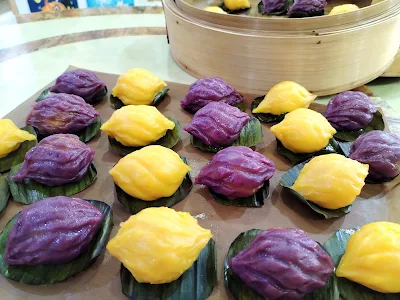Red Tortoise cake (Ang Ku Kueh)
This red tortoise cake is something that I think everyone has heard of and has probably used in worship. The Hokkien dialect "Ang Ku Kueh" is where the name "red tortoise cake" or "Hong Gui Kueh" originates. The primary component is glutinous rice, which is coloured and wrapped with your preferred cooked fillings. Usually, either mung beans or peanuts are used as the filler. Banana leaves are always used to line the bottom.
In the old days, folks would
typically grind glutinous rice pulp in a stone mill. But now is very convenient
to use store-bought glutinous rice flour to prepare it. It is much easier, just pour boiling water
into the flour.
I am sharing three flavours of Ang Ku Kueh, which are pumpkin, sweet potatoes and pandan flavour. To make the cake's skin, I
combined glutinous rice flour with mashed purple sweet potatoes and pumpkin respectively.
In other words, rather than being red, the natural colour of my Ang Ku Kueh is
purple and yellow. The traditional dessert has been altered and boosted with
custard filling due to the changes in younger people's tastes for the filling.
For the pumpkin and sweet potato dough. I've tried two different ways to make the skin. For the first attempt, I poured boiling water into the glutinous flour to make the dough, but the “Kueh” skin tasted too soft to me after steaming. I prepared a “starter” paste or water roux with rice flour for the second approach and evenly mixed it with the glutinous flour. For the pandan flavour dough, since it does not contain any puree, so I omit the "starter"
“Starter “paste or water roux is a cooked mix of rice flour and water. It makes the dough easy to handle and the cake skin will be chewier to eat and won't stiffen overnight. The texture of the kueh is still chewy but not hard to eat the next day when the skin is made by mixing mashed sweet potato, pumpkin, or potato with glutinous flour. If you only use glutinous rice flour in its entirety, the cake will somewhat crumble after steaming.
Instead of using a mould, I'm making this ang ku kueh using a foam fruit wrapper. Place the dough on the foam fruit wrapper, roll it up, gently squeeze and twist it into a shell shape of Ang Ku Kueh.
A piece of oiled banana leaf normally need to line the bottom of the kueh before steaming. Or you may line it on top of a piece of parchment paper. Do remember to brush in oil in a container for storing. And brush in oil on a plate before serving.
Let us get all the ingredients to
hand and detailed instructions to get started.
INGREDIENTS
CUSTARD FILLING
120g custard powder
80g milk powder
90g sugar
200ml coconut milk
160ml milk
2 eggs (beaten)
50ml cooking oil
(Divided into 30 portions and form 30 little balls)
STARTER PASTE
10g rice flour
100ml warm water
2 tbsp oil
PUMPKIN SKIN
200g pumpkin puree
200g glutinous rice flour
1 tbsp sugar
2 tbsp cooking oil
Half of the starter
PURPLE SWEET POTATO SKIN
230g mashed purple sweet potatoes
230g glutinous rice flour
1 tbsp sugar
2 tbsp cooking oil
Half of the starter
PANDAN FLAVOUR SKIN
250g glurinous rice flour
1 tbsp sugar
2 tbsp cooking oil
240ml pandan juice (5 pandan leaves blended with 240ml of water)
METHOD
1. Combine the starter paste material
in a saucepan and stir well. Make sure that there are no lumps. Cook it at low heat stirring continuously
until the roux thickens.
2. For the pumpkin skin - Pour in 1
tbsp of sugar into the glutinous rice flour and stir well. Add in half of the
starter from step (1) and mix until incorporated. Then add the pumpkin puree
and the cooking oil, stir, and knead until you get a smooth dough. If the dough
is too wet to handle, add 1 tablespoon of glutinous flour, one at a time, until you
get a perfect dough. Divide it into 18 potions and form into little balls.
3. For the purple sweet potato skin –
follow the same method as making the pumpkin dough. If the dough is too dry to
handle, add 1 tablespoon of water, one at a time until you get a smooth dough. Divide
it into 12 potions and form into little balls.
4. For the pandan flavour skin - Combine the glutinous rice flour, sugar, cooking oil, and pandan juice. Mix it well until you get a smooth dough. If the dough is dry, add 1 tablespoon of water (or pandan juice if you have made extra), until you get a smooth dough. Divide it into 12 potions and form into a little balls.
4. Flatten the dough (pumpkin, sweet potato or pandan) and wrap in the
fillings. Knead and roll into oval shape and place the dough on the foam fruit
wrapper, gently squeeze and twist into a shell shape. Use a piece of oiled
banana leaf to line the bottom of the kueh. Steam on medium and low heat for 10
to 12 minutes.








Comments
Post a Comment